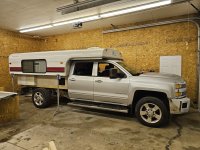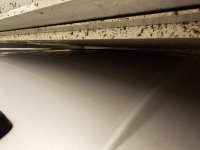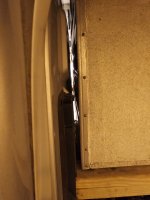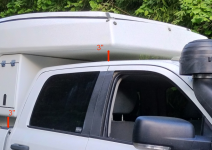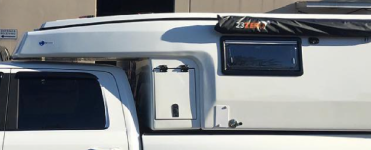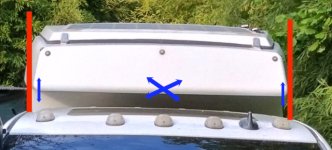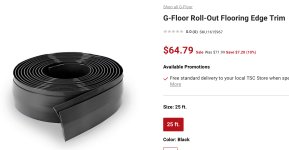The pickup is a 2018 Silverado 3500 8' pickup bed, duramax. Camper is a 2001 10' CO Alaskan. I removed the pickup bed and will be installing a flatbed.
I am mocking up my camper so I can get going on my flatbed build. The wood is only for mockup purposes, the flatbed is not going to be made out of wood.
This is as tight as I can get it, now I need to figure out how much I need to back it off.
This camper is sitting on a frame made of two 2x4's stacked, so as this sits it is 3" above the truck frame. I have about 1" between the camper and the back of the cab, 1" clearance to open the rear cab doors, and the closest point between the cab roof and the camper is 1/2".
What do you all think those clearances should be? For reference, the top rail on the factory bed sits 1" from the cab.
I am thinking of trying to stick to the 1" between the camper and the cab. Add another 1/2" between the frame and the camper to give me an 1" on the closet point between the camper and the cab.
If I go that route I would build a flatbed that would have my camper sitting 3 1/2" above the truck frame. I plan to add 1" sides to my flatbed that match the footprint of the camper, so the camper will "sit" in the flatbed and shouldn't slide around. Of course I will also mount the camper to the flatbed. I mention the sides so you know that the camper shouldn't slide around, and hit the truck cab.
I am mocking up my camper so I can get going on my flatbed build. The wood is only for mockup purposes, the flatbed is not going to be made out of wood.
This is as tight as I can get it, now I need to figure out how much I need to back it off.
This camper is sitting on a frame made of two 2x4's stacked, so as this sits it is 3" above the truck frame. I have about 1" between the camper and the back of the cab, 1" clearance to open the rear cab doors, and the closest point between the cab roof and the camper is 1/2".
What do you all think those clearances should be? For reference, the top rail on the factory bed sits 1" from the cab.
I am thinking of trying to stick to the 1" between the camper and the cab. Add another 1/2" between the frame and the camper to give me an 1" on the closet point between the camper and the cab.
If I go that route I would build a flatbed that would have my camper sitting 3 1/2" above the truck frame. I plan to add 1" sides to my flatbed that match the footprint of the camper, so the camper will "sit" in the flatbed and shouldn't slide around. Of course I will also mount the camper to the flatbed. I mention the sides so you know that the camper shouldn't slide around, and hit the truck cab.

